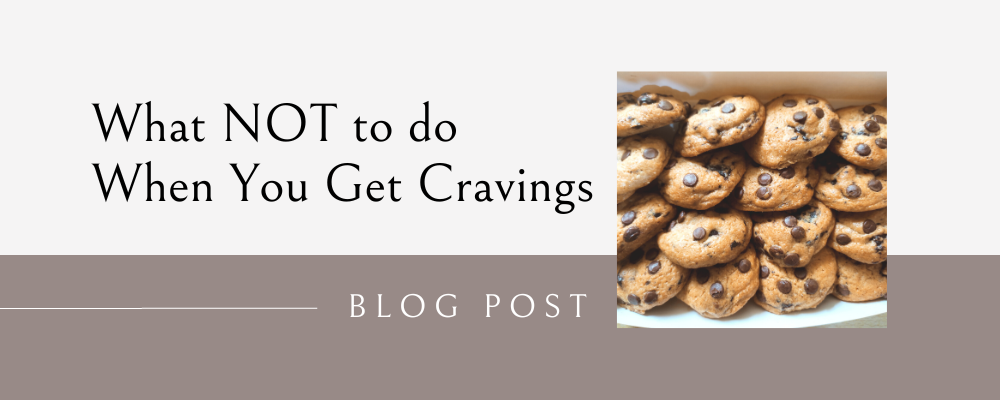What NOT to do When You Get Cravings

What NOT to do When You Get Cravings
Food cravings and especially cravings for sweet, salty, crunchy foods will come up. They might come up only occasionally for you or very frequently.
They can feel out of your control when they come on and it also may feel like how you respond is out of your control too.
In this post, I’m sharing what NOT to do when you get cravings, plus what to do instead. So, whether you get cravings frequently or occasionally, I’ll help you respond to them in the way that will help you move past the craving more easily.
You’ll feel much more in control and the craving won’t feel as badly. You’ll notice less intensity and frequency of the cravings over time too.
Two Typical Responses to Cravings
The first typical (or “normal”) response to cravings is to fight against or try to resist the craving.
You feel a craving come on, you try to fight against it by willing your body NOT to go to the kitchen, or willing your arm NOT to reach out for a brownie. You keep thinking about the food you have the craving for, and keep trying to fight against it.
Only to give in. Maybe not 100% of the time, but more times than you’d like.
The second typical response to a craving is to just act upon it automatically. This is when the craving has become more of a habit.
You get the craving (which is the trigger) and you automatically act upon it by reaching for and eating the food you got the craving for. You get the bit of pleasure from the food and then that reinforces the habit cycle.
After I share what NOT do to when you get cravings, I’ll provide a technique to do instead. The technique I’ll share helps with both.
- LISTEN OR READ: Food Craving vs. True Hunger (Podcast Episode)
- LISTEN OR READ: Why Willpower Fails (Podcast Episode)
Don’t Fight the Craving
So, what NOT to do when you get cravings, is to fight or resist it. Fighting or resisting a craving by having this mental battle, actually makes the craving last longer. It can also intensify the craving.
Here’s why. When you fight the craving, you’re thinking about it more. When you think about it more, you keep that feeling of the craving alive in your body. That’s because your thoughts create your feelings.
If you keep feeling that craving, guess what will end up happening? You’ll be more likely to act upon it by eating the food you were trying to resist.
So, if you want to avoid this, then you’ll need to do something differently.
- GET WEEKLY TIPS: Eating Habit and Weight Loss Tips
- READ: How to Say “No” to Sugar at Work (Blog Post)
What to do Instead of Fighting a Craving
Instead of fighting or resisting a craving, just allow it. Allow that feeling to be there for a bit. It’s not terrible and it’s something you’ll have more control of if you are nice and calm about it.
Invite it in for a little visit, sit with it for 30 seconds (or longer if you can). Imagine it’s a little visitor in your home. (This little visual may seem silly, but it really helps.)
Invite it in for tea for a bit and then just let it know that it’s time to go. Because it’s YOUR house. Not the craving’s house. So, you get to decide when it’s time to just say “goodbye” to that craving and let it on its merry way.
Now, this may not go perfectly the first few times, and you may end up still eating the food you were trying to avoid, but that’s okay. As long as you allowed that craving to stay for a bit rather than fight it.
When you do this each time, you’re showing your brain that you can experience a feeling (the craving). Little by little, you’ll show your brain that you can experience it AND let it pass by without reacting to it in a way in which you don’t want to.
You feel way more in control, plus it lets the craving not hang around for any longer than it needs to. It gets less and less intense and less frequent. And even if or when it does come up, you know that you can just sit with it for a bit and not react negatively to it.
It’ll be like, “Craving? No problem, I’ve got this.”
And by the way, if you feel like you often don’t fight a craving and usually automatically just act upon it, this technique still helps. It helps you just take a pause before acting on it. You can still sit with that craving for a very short period of time.
Putting this bit of space between the trigger and the response, helps to break that habit. It helps break that automaticity.
- LISTEN OR READ: Breaking Your Sugar Habit (Podcast Episode)
- LISTEN OR READ: Sugar Cravings and Your Brain (Podcast Episode)
Final Notes (& More Tips)
It only makes sense that a because an eating habit takes more than a day to form, it’ll take more than a day to break too. So this won’t be an overnight quick fix. BUT, you can start seeing improvements very quickly.
It’s about progress, not perfection right away. Aim for the progress and you’ll get as close as you can to perfection (if that’s your goal).
To help you stay on track each week, I invite you to receive eating habit and weight loss tips on Sundays via email. Just drop your first name and email below to get weekly help.

KATE JOHNSTON
Weight Loss Coach, PA-C
Helping busy career women lose weight simply, by changing their eating habits (and mindset) for life.
Want to see how I can help you specifically? Just with the free consultation, you’ll get insight, clarity, and direction that’ll move you forward.
